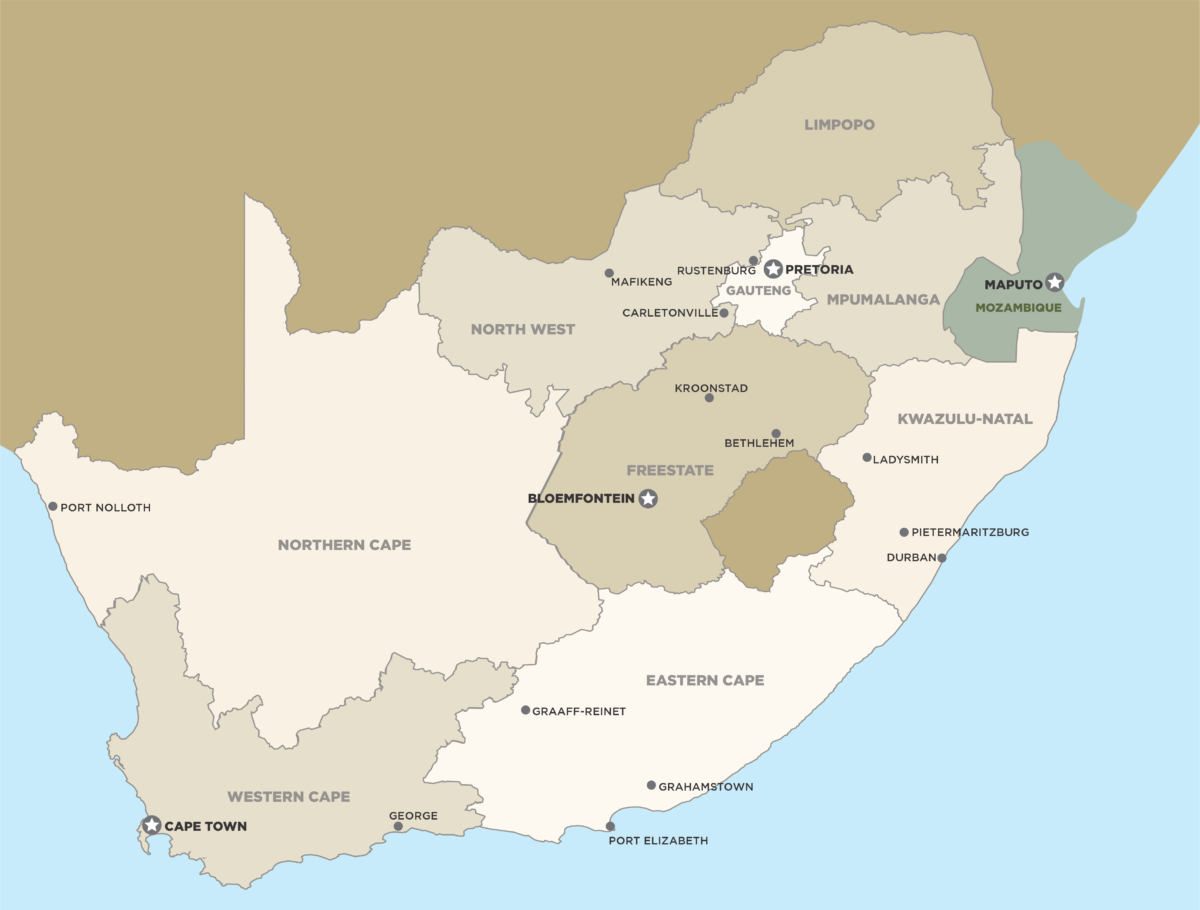HERITAGE SITES

KAREL LANDMAN MONUMENT (ALEXANDRIA, PORT ELIZABETH)
EASTERN CAPE
The Voortrekker Karel Landman was second in command during the Battle of Blood River (16 December 1838). A monument in his honour was erected near Alexandria in the Eastern Cape Province, the area from which he originally moved. In 2012, the monument was transferred to the Heritage Foundation by the Karel Landman Voortrekker Monument Committee.
S 33°34.42 O 26°09.43

KERKENBERG
KWAZULU-NATAL
During the trek to Natal, the Voortrekkers camped out here while waiting for news from their leader, Piet Retief. The name Kerkenberg comes from the fact that Reverend Erasmus Smit led worship services between the two rocks. Debora Retief painted the date, 12 November 1837, against the rock on her father, Piet Retief’s birthday. This date is still visible today.
S 28°30’19.7O 29°06’34.7

BAREFOOT WOMAN MONUMENT
KWAZULU-NATAL
The statue of the Barefoot Woman was erected in memory of the brave Voortrekker women of Pietermaritzburg who, after the British annexation of Natal (1842), said that they would rather “walk barefoot over the mountains than live under British control again”. From this site, visitors can also see the Blye Vooruitsig scene that the Voortrekkers saw after leaving Kerkenberg. It is also the route that Retief’s company used to descend the Drakensberg to the region that would later become the Republic of Natalia.
S 29°08.577 O 28°33.199

BLOUKRANS MONUMENT
KWAZULU-NATAL
During the night of 16 to 17 February 1838, the Voortrekker camps on the banks of the Bloukrans River in KwaZulu-Natal were attacked by a Zulu force and almost completely wiped out. These moving events are commemorated by a marble monument on the site where the victims were all buried together in a mass grave. Voortrekker leader Gert Maritz’s grave also forms part of the monument. The area around the monument, which previously belonged to the Natal Dutch Reformed Church, was transferred to the Heritage Foundation in 2004.
S 28°51’1.94 O 29°50’34.43

KROONSTAD CONCENTRATION
CAMP CEMETERY
CAMP CEMETERY
FREE STATE
Kroonstad’s concentration camp was one of eleven Free State camps during the Anglo-Boer War (1899–1902). General Kelly-Kenny proposed on 7 September 1900 that a concentration camp be established in Kroonstad and by 24 November 1900 the camp already existed. By March 1901, the Kroonstad camp was already relatively large, with a population of about 2 500. It is estimated that 1 268 people died in the period Kroonstad camp from April 1901 to April 1902. Kroonstad’s concentration camp was only officially closed on 12 January 1903 and the last inhabitants finally evacuated the camp on 4 February 1903.
S 27°40’17.82, O 27°12’22.81

MAFIKENG CONCENTRATION
CAMP CEMETERY
NORTHWEST
In 2007 the Heritage Foundation took over the ownership of the two concentration camp cemeteries of the Dutch Reformed Church in Mahikeng. The concentration camp at Mahikeng, erected during the Anglo-Boer War (1899–1902), was close to the Molopori River. The large cemetery contains 825 marked graves and is in good condition. It also contains the remains of 33 civilians who were killed during the Anglo-Boer War with the siege of Mahikeng and were previously buried in various places. Several memorial needles were erected on the site, as well as a memorial wall with the names of the deceased. The smaller one has about 200 graves and is in the middle of a local residential area.
S 25°52’49.58 O 25°36’27.48

BOEKENHOUTFONTEIN HERITAGE SITE
NORTHWEST
Members of the Heritage Foundation’s management team have been trustees of the President Paul Kruger Trust since 2011. The trust aims to conserve and manage Boekenhoutfontein just outside Rustenburg, the farm of Pres. Paul Kruger since the 1860s, in collaboration with the owners of the site, the Kedar Country Lodge. In 2014, the Heritage Foundation restored the ceiling of the main house. The Heritage Foundation also organised the first Paul Kruger Festival on the site in 2012 but has since transferred the function to the Rapportryerskorps in Rustenburg.
S 25°33.397 O 27°07.303

DANIE THERON MEMORIAL COLUMN
GAUTENG
The Danie Theron memorial pillar was erected in Gatsrand on Theronskop, on the site where the famous Boer explorer was shot dead during the Anglo-Boer War (1899–1902). The site was donated to the Heritage Foundation in 2003 by the Voortrekker Youth Movement. The Heritage Foundation has entered into a management agreement with the nearby Anglo Gold Ashanti Mine, which has assumed responsibility for the maintenance of the road, as well as the regular cleaning of the site. It commemorates the heroic deeds of the master scout Danie Theron during the Anglo-Boer War. The monument stands about 50 meters from the place where Theron died on 5 September 1900.
S 26°27’06, O 27°26’14

OSSEWABRANDWAG CEMETERY
GAUTENG
In 2012, the ES took ownership of the Cemetery, which contains 99 graves (including those of the Ossewabrandwag leader, JF van Rensburg and JC Neethling, the first husband of the legendary actress Anna Neethling-Pohl. The Ossewabrandwag was established as a cultural organisation in Bloemfontein on 4 February 1939 – a direct result of the rise of Afrikaner nationalism after the Symbolic Ox Wagon Trek of 1938. The body was strongly opposed to South Africa’s involvement in the Second World War.
S 25°51’51.55 O 28°10.25.15

LOUIS TREGARDT MEMORIAL GARDEN
MAPUTO, MOZAMBIQUE
The Louis Tregardt Memorial Garden in Maputo, Mozambique, contains, among other things, the graves of the Voortrekker leader Louis Tregardt, his wife Martha and eighteen members of the trek company who died of malaria in 1836. The memorial garden was visited in March 2022 by a team from the Heritage Foundation, Voortrekker Monument and FAK to carry out necessary repairs. Visiting the monument is free and worth including in the itinerary when planning your next Mozambique holiday.
S 25°58’05.70 O 32°34’16.10


